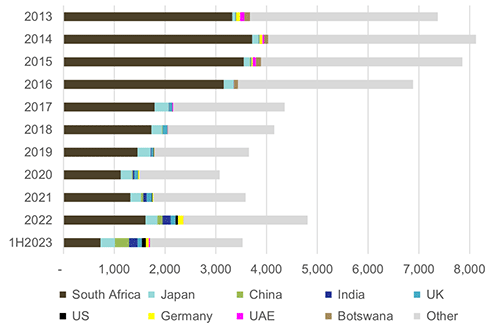Namibia’s sources of vehicle imports expose a pronounced concentration risk. This is because more than 80% of all vehicles imported into Namibia are sourced from South Africa which represents a significant majority of the country’s total vehicle import expenditure.
In addition, Japan’s share in Namibia’s vehicle import expenditure has been increasing steadily. This, local stock brokerage Simonis Storm pointed out, is possibly attributable to advantages stemming from Japan’s more stable economy and skilled workforce, coupled with trusted brands in high demand in Namibia. These brands include Toyota, Honda, Nissan, Mazda, Subaru, Mitsubishi, Suzuki, Isuzu and Daihatsu.
“This trend has the potential to reduce costs for dealers and contribute to the shifting dynamics within the import landscape,” an SS report pointed out.
Meanwhile, the latest sales figures show that Toyota remains the driver of the domestic market by contributing 45% of total sales, followed by Volkswagen (12%), Kia (8%), Ford (7%) and Nissan (4%). According to market participants, the new Ford Raptor Ranger is in high demand with more than 1 000 Windhoek customers still on the waiting list.
“Demand for new vehicles in Namibia has decreased for the third consecutive month, down by 3.7% month-on-month (m/m) in September 2023, compared to -13.2% m/m in August 2023. 1,054 vehicles were sold in September, below the six-month moving average. Vehicle sales have increased by 3.5% year-on-year (y/y) in September 2023,” the SS report reads.
Meanwhile, over 9 800 vehicles were sold between January to September, which is the highest number since 2017.
According to National Association of Automobile Manufacturers of South Africa (NAAMSA), whose official figures include Namibian sales, the automotive sector is currently grappling with a lack of consistent performance, primarily attributed to concerns regarding consumer affordability. This issue appears to be mirrored in Namibia as well given sales are decreasing on a monthly basis.
This is as elevated repo and prime rates have deterred consumers from seeking vehicle financing.
SS noted that vehicle prices have exhibited an upward trajectory, increasing by 10% y/y. Moreover, escalating global oil prices have led to a surge in fuel costs, while the overall cost of living having witnessed a similar upward trend, rendering it increasingly challenging for consumers to consider purchasing new vehicles.
SS further pointed out that personal transport operations prices only grew marginally by 0.1% y/y in September, following a sequence of three consecutive months marked by deflationary pressures.
“Engagements with various stakeholders have revealed that new vehicle acquisitions accounted for 75% of the total sales in September, mirroring the statistics of the preceding month. There is a noticeable decline in the proportion of vehicles being purchased on credit, with credit sales representing 36% of sales, while cash transactions accounted for 64%. Many local dealers are proactively offering extended payment holidays to entice potential buyers. Additionally, the heightened demand for vehicles among businesses suggests a positive sentiment in the local market, indicating a propensity for business expansion,” SS reported. The stock brokerage continued that businesses and households are net borrowers of instalment and leasing credit. According to Bank of Namibia, instalment and leasing credit grew by 17.7% y/y in August 2023, compared to 16.6% y/y in July 2023 for businesses and 6.1% y/y in August 2023, compared to 6.1% y/y in July 2023 for households.
Also, passenger vehicle sales experienced an increase of 3.9% m/m and commercial vehicle sales decreased by 11.3% m/m in September 2023. On an annual basis, passenger vehicle sales increased by 4.6% y/y and commercial vehicle sales by 2.5% y/y in September 2023.
“Commercial vehicle sales were primarily driven by the 458 units of light commercial vehicles (up 2.2% y/y) and extra-heavy commercial vehicles (up 28.6% y/y) sold in September 2023. 17 medium (down 19% y/y), 13 heavy (down 13.3% y/y) commercial vehicles and two buses were sold in September 2023,” SS stated.


